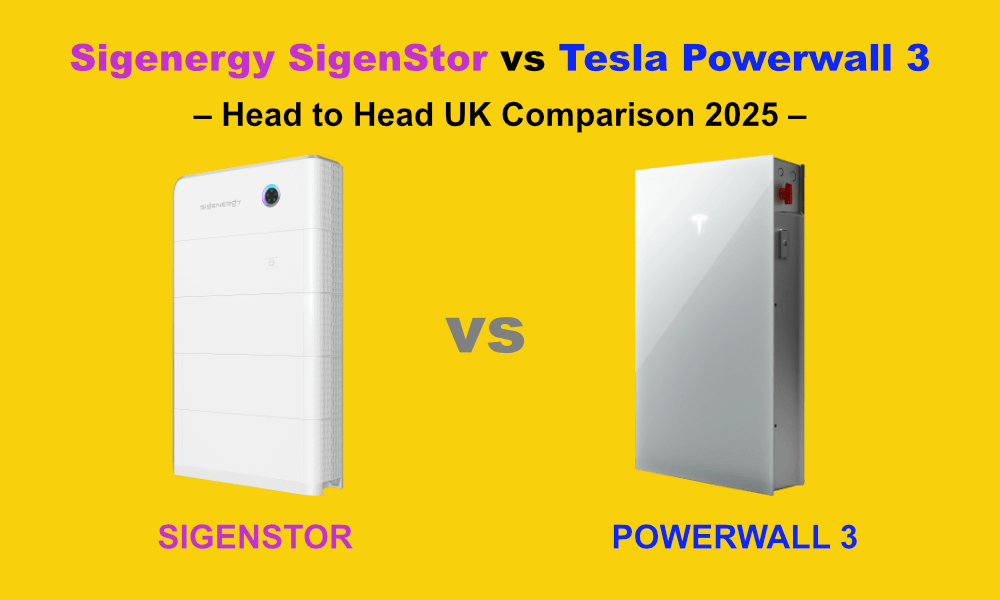Tesla Powerwall 3:
What is the Tesla Powerwall 3?
The Tesla Powerwall 3 – an upgraded version of the Powerwall 2 – is the ultimate home battery storage system, revolutionising energy independence for UK households with its 13.5 kWh capacity and powerful output up to 11.04 kW.
Now with an integrated hybrid inverter, it seamlessly stores solar energy, provides reliable backup during outages (with the optional Gateway), and optimises grid usage to slash your bills.
Whether you’re going green or prepping for blackouts, this sleek, scalable powerhouse from Tesla delivers unmatched efficiency and peace of mind.

What are the benefits of the Tesla Powerwall 3?
- Capture surplus solar electricity – if you have solar panels, Powerwall 3 will automatically store excess solar for later use
- A massive 13.5 kWh of storage capacity – the average house needs just 10 kWh of electricity per day
- Power output rating up to 11.04 kW – enough to power multiple electrical devices simultaneously
- Emergency power in a power-cut – if the national grid goes down, you can still power your property via the Powerwall (optional extra)
- Tesla Powerwall 3 now comes with an integrated solar inverter – save £100s if you are getting solar panels installed as well
- Store cheap, off-peak electricity – top up your battery storage with low-cost electricity and discharge when grid rates are high

How does Tesla Powerwall 3 work?
Tesla has been perfecting the Powerwall since it first came out in 2015. This third version – Powerwall 3 – is incredibly versatile and can be installed in different ways, depending on your exact needs.
With solar panels
If you are getting solar panels and battery storage installed at the same time, the best way to connect the Powerwall is ‘DC-coupled’. This is how it works:
- Your solar panels are connected to the inverter inside the Powerwall, meaning you don’t have to purchase a separate solar inverter.
- When the sun shines on your solar panels – producing Direct Current (DC) electricity – the DC electricity either flows directly into your Powerwall battery and is stored for later use, or the DC electricity is converted by the Powerwall inverter into Alternating Current (AC) electricity for you to use at that moment.
- Stored DC electricity inside the Powerwall 3 is converted into AC electricity, as and when it is needed by the property or business.
- All the electrical flows and conversions are coordinated automatically by a separate box called the Tesla Gateway. The Gateway monitors electricity flowing into and out of the building, as well as which devices need power, and regulates Powerwall charging and discharging accordingly.


Without solar panels
Tesla Powerwall 3 can also be installed without solar panels via an ‘AC-coupled’ installation which allows you to:
- Charge your Powerwall with cheap off-peak electricity. You need to sign up to a tariff with your energy supplier that has both a cheap rate (usually at night) and a normal day rate. For example, you could charge up at say 7.5p per kWh overnight and then discharge that cheap electricity into your property during the day when you would normally be paying around 28p per kWh.
- A Powerwall 3 without solar panels still means you can benefit from whole-home emergency power in a power-cut, if you select the optional Gateway. So if you live in an area of the UK where power-cuts are more frequent, a Powerwall can help you keep the lights on when your neighbours are in the dark.
- Without solar panels, the Powerwall is only charged with AC electricity from the grid. That grid AC electricity is converted into DC electricity by the Powerwall’s built-in inverter and stored, and then converted back into AC electricity when needed by the property.
Core Technology Explained
At the heart of the Tesla Powerwall 3 lies advanced engineering that sets it apart from previous models and competitors. This section breaks down the key innovations, highlighting how they enhance performance, efficiency, and ease of integration for UK homeowners.
Integrated Hybrid Inverter
The Tesla Powerwall 3 features a fully integrated hybrid inverter, which combines solar power conversion, battery storage management, and grid interaction into a single, compact unit. Unlike traditional systems that require separate inverters for solar panels and batteries, this all-in-one design streamlines the entire setup. It converts direct current (DC) from solar panels or the battery into alternating current (AC) for home use, while also allowing excess energy to be stored or fed back to the grid. This integration offers several advantages:
- Simplified Installation: Fewer components mean quicker setup times and lower labour costs, making it ideal for both new solar installations and retrofits.
- Scalability and Oversizing: The inverter supports up to 20 kW of solar input (170% oversizing), allowing you to connect more panels than the system’s rated output. This is particularly useful in the UK, where variable weather demands flexible solar capacity.
- Enhanced Efficiency: By eliminating energy losses from multiple conversion stages, the system achieves higher round-trip efficiency – up to 97.5% – ensuring more of your generated solar power is usable.
- DNO Compliance Support: For installations exceeding 3.68 kW, the hybrid inverter can dynamically limit export to meet Distribution Network Operator (DNO) requirements, increasing approval chances without additional hardware.
SUMMARY > Overall, the integrated hybrid inverter makes the Tesla Powerwall 3 a more reliable and cost-effective choice for maximising energy independence.
3 MPPT Strings: Benefits Explained
Maximum Power Point Tracking (MPPT) is a sophisticated technology that continuously adjusts the operating point of solar panels to extract the maximum possible power, even under changing conditions like shading, temperature fluctuations, or cloud cover. The Tesla Powerwall 3 includes three independent MPPT strings, enabling it to handle inputs from up to three separate solar arrays or panel groups.
Here’s why this feature delivers real-world benefits:
- Optimised Performance Across Roofs: With three strings, you can connect panels from different orientations (e.g. east, west, and south-facing) without compromising efficiency. Each string operates independently, ensuring the underperformance of one group doesn’t affect the others.
- Superior Shading Mitigation: In the UK’s often unpredictable weather, partial shading from trees, chimneys, or buildings can reduce output. Multiple MPPT strings minimise these losses by isolating and optimising affected sections, potentially boosting overall energy harvest by 5-10%.
- Increased System Flexibility: This setup supports diverse solar configurations, making it easier to expand your array over time. It’s especially advantageous for homes with complex roof layouts or limited space.
- Improved Energy Yield and ROI: By maximising power extraction, the three MPPT strings help you generate more electricity from the same panels, shortening payback periods and enhancing savings on energy bills.

SUMMARY > Incorporating three MPPT strings underscores the Tesla Powerwall 3’s commitment to adaptability and high performance in real UK conditions.
Powerwall 3 Scalability: Single Units and Expansion Packs
The Tesla Powerwall 3 is engineered for flexibility, allowing UK homeowners to start with a basic setup and scale as energy needs evolve – whether due to growing household demands, EV charging, or increased solar production. This scalability comes through single-unit installations, cost-effective expansion packs for added storage, and multi-unit configurations for enhanced power output. Below, we explore these options to help you tailor a system that fits your home.
SINGLE UNIT CONFIGURATION
A standalone Tesla Powerwall 3 provides a robust foundation for home energy storage, ideal for most UK properties with moderate energy usage. Each unit delivers 13.5 kWh of usable capacity and up to 11.04 kW of continuous power output, sufficient to power essential appliances during outages or optimise solar self-consumption. With its integrated hybrid inverter, a single Powerwall 3 handles solar input up to 20 kW, making it compatible with a wide range of PV systems without additional hardware.
Key benefits include:
- Energy Independence for Average Homes: Store enough power to cover evening usage or short blackouts, reducing reliance on the grid and potentially saving on tariffs like Octopus Energy’s Intelligent Octopus.
- Compact and Efficient Design: At just 130 kg and wall- or floor-mountable, it’s easy to install in garages or utility rooms, with IP67 weather resistance for outdoor setups.
- Future-Proofing: Start small and expand later – perfect for budget-conscious users or those testing solar storage.

SUMMARY > This configuration is often the entry point for UK installations, especially where DNO limits cap export at 3.68 kW per phase, as the system can dynamically manage output for compliance.
EXPANSION PACKS FOR ADDED CAPACITY
For households needing more storage without proportionally increasing costs, Tesla offers Powerwall 3 Expansion Units (also called DC Expansion Packs). These are battery-only add-ons that connect directly to a primary Powerwall 3, each providing an additional 13.5 kWh of capacity. You can stack up to three expansion packs per main unit, scaling total capacity to 54 kWh while relying on the leader unit’s inverter for power management. Advantages of this approach:
- Cost-Effective Scaling: Expansion packs are more affordable than full Powerwall 3 units since they omit the inverter, making it easier to boost storage for high-consumption homes or off-peak tariff optimisation.
- Seamless Integration: They connect via DC coupling to the leader unit, maintaining the system’s 97.5% round-trip efficiency and compatibility with 3-phase setups.
- Enhanced Resilience: With expanded capacity, you can sustain longer outages or store more solar energy during the UK’s shorter winter days, improving ROI through greater bill savings.
- Limitations to Note: Expansions don’t increase power output beyond the main unit’s 11.04 kW – ideal for storage-focused needs but not for high instantaneous loads.

MULTI-UNIT STACKING FOR MAXIMUM POWER AND CAPACITY
For larger homes or commercial-like demands, multiple full Powerwall 3 units can be stacked in parallel, with each additional unit boosting both capacity (13.5 kWh) and output (up to 11.04 kW per unit). Systems can support up to four units, achieving outputs like 22.08 kW with two units, while still allowing expansions on each leader. This setup is perfect for UK properties with heat pumps, multiple EVs, or whole-home backup requirements.
SUMMARY > Whether opting for a single unit, adding expansion packs, or building a multi-unit array, the Powerwall 3’s scalability ensures your system grows with you, delivering long-term value in the UK’s evolving energy landscape. Contact our Tesla-certified team for a personalised quote.
Single-Phase vs 3-Phase
Understanding the difference between single-phase and three-phase electrical supplies is crucial when installing a Tesla Powerwall 3 in the UK. Most residential homes use single-phase power, where electricity is delivered via one live wire, suitable for standard appliances.
Three-phase systems, common in larger properties or those with high-power needs like heat pumps or workshops, distribute power across three live wires for better efficiency and capacity. The Tesla Powerwall 3, being a single-phase device at its core, is fully compatible with both setups but with key differences in installation, backup capabilities, and scalability. Below, we compare the two to help you choose the right configuration for your home.
SINGLE-PHASE INSTALLATIONS
In a single-phase setup, the Tesla Powerwall 3 integrates seamlessly, providing robust performance for typical UK households. This is the most straightforward option, as the system’s integrated hybrid inverter aligns directly with the home’s electrical supply. A single unit can deliver up to 11.04 kW of continuous power and 13.5 kWh of storage, often sufficient for whole-home backup during outages.
Key features and benefits:
- Full Backup Capability: Enables whole-home backup (with the optional Gateway), powering all essential loads without restrictions during grid failures.
- Scalability: Stack up to four full Powerwall 3 units for a theoretical maximum of 44.16 kW output and 54 kWh per leader unit (though in the UK, output is normally limited by the DNO to 17 kW), or add up to three expansion packs per unit for total storage up to 216 kWh across the system.
- Installation Simplicity: No need for phase balancing; solar PV can connect directly to the same phase for optimal charging from excess generation.
- UK Considerations: For systems over 3.68 kW inverter rating, a G99 DNO application is required, but export limiting ensures compliance.
SUMMARY > This configuration is ideal for average-sized homes aiming for energy independence and seamless integration with solar panels.

3-PHASE INSTALLATIONS
For homes with 3-phase supplies, the Tesla Powerwall 3 can be installed by distributing multiple units across the phases to balance the load and support higher overall capacity. This allows for greater power handling, but comes with some limitations compared to single-phase setups. Key features and benefits:
- Enhanced Capacity: Multiple units (e.g. one per phase) enable higher total output – up to 11.04 kW per unit – making it suitable for energy-intensive properties. Stacking follows similar limits as single-phase, but units must be evenly distributed for compliance with local generation imbalance rules.
- Grid-Tied Performance: While on-grid, the system efficiently manages solar input and storage across phases, with PV circuits connected to the same phase as the Powerwall for charging.
- Backup Limitations: During outages, backup is provided only to a selected single phase (L1, L2, or L3), meaning full whole-home backup across all phases isn’t supported – Powerwalls on non-backup phases won’t operate off-grid. Critical loads should be wired to the backup phase to ensure continuity.
- UK Considerations: Requires DNO approval (G99) for larger installations, and 3-phase equipment or PV inverters should not be on the backup side to avoid damage during off-grid mode. This setup may involve higher costs for rewiring if loads need redistribution.
SUMMARY > 3-phase configurations are best for larger UK homes where high power distribution is needed, but if full multi-phase backup is essential, consult us for alternatives or additional solutions.
ASPECT | SINGLE-PHASE | 3-PHASE |
Backup Coverage | Whole-home on single phase | Limited to one selected phase |
Max Stacking | Up to 4 units + 3 expansions each (216 kWh total) | Similar stacking, distributed across phases |
Power Output | Up to 44.16 kW with 4 units (UK DNO limit is c. 17 kW) | Higher potential with phase balancing, but per-unit 11.04 kW |
Installation Complexity | Simpler, no balancing needed | Requires even distribution and phase-specific wiring |
Ideal For | Standard homes | Large properties with high loads |
Advanced Features
The Tesla Powerwall 3 goes beyond basic energy storage with intelligent features that enhance reliability and cost savings for UK users. Leveraging smart software and integrations, it adapts to weather patterns and energy market dynamics, ensuring optimal performance in real-world scenarios.
Below, we delve into two standout advanced capabilities: Storm Watch for outage preparedness and seamless integration with Octopus Energy tariffs for smarter billing.
Storm Watch
Storm Watch is a proactive feature in the Tesla Powerwall 3 that automatically prepares your system for severe weather events, helping to maintain power during potential outages.
Integrated into the Tesla app, it monitors local weather forecasts in collaboration with services like the UK’s Met Office.
When an Amber or Red alert is issued – particularly those mentioning risks of power cuts – the system activates to charge the battery to full capacity, even drawing from the grid if solar production is insufficient.
Key benefits include:
- Outage Readiness: Ensures maximum stored energy (up to 13.5 kWh per unit) is available, powering essential home loads like lights, fridges, and heating during storms or blackouts.
- Automated Intelligence: No manual intervention needed; the feature overrides normal modes to prioritise charging, adapting to the UK’s increasingly unpredictable weather patterns.
- Peace of Mind: Reduces disruption from events like high winds or floods, which are common in the UK, by preemptively securing energy independence.
SUMMARY > This feature is especially valuable in regions prone to extreme weather, making the Powerwall 3 a resilient choice for UK homes.

Octopus Tariff Integration
The Tesla Powerwall 3 integrates directly with Octopus Energy’s smart tariffs, allowing UK customers to automate energy usage for maximum savings through the Kraken platform.
Compatible tariffs include Intelligent Octopus Flux, which optimises charging during low-price periods and discharging or exporting during high-price windows.
Setup involves linking your Tesla account via the app, enabling real-time tariff data to guide the Powerwall’s behaviour – such as importing cheap off-peak energy or exporting solar surplus under the Smart Export Guarantee (SEG).
Advantages for UK users:
- Cost Optimisation: Automatically charges the battery when rates are low (e.g. overnight) and uses stored energy during peak times, potentially slashing bills by up to 30% on tariffs like Flux or Agile.
- Seamless Automation: Tracks system health, detects solar issues early, and supports dynamic pricing without manual adjustments, ideal for homes with solar PV or EVs.
- Expanded Savings: Eligible for add-ons like Powerwall 3 Expansion Packs through Octopus, boosting storage while maintaining tariff compatibility.
SUMMARY > Note that while most smart tariffs are supported, compatibility may vary – consult Octopus or Infinity Energy Services for your setup. This integration positions the Powerwall 3 as a key player in the UK’s smart energy ecosystem. Contact us to explore how these features can work for your home.
LFP Battery Chemistry Explained
The Tesla Powerwall 3 utilises Lithium Iron Phosphate (LFP) battery chemistry, a significant advancement over the Nickel Manganese Cobalt (NMC) cells found in earlier models like the Powerwall 2. LFP, or LiFePO₄, employs iron phosphate as the cathode material, offering a more stable and durable structure for energy storage. This choice by Tesla enhances the system’s overall performance, making it particularly well-suited for UK homes where reliability and safety are paramount amid variable weather and increasing energy demands.
One of the primary advantages of LFP chemistry is its exceptional safety profile. Unlike other lithium-ion batteries, LFP cells have a higher thermal stability, significantly reducing the risk of thermal runaway – a condition that can lead to overheating or fires. This makes the Powerwall 3 a safer option for residential installations, especially in compact UK properties where batteries might be placed indoors or in garages.
LFP also excels in longevity and cycle life. These batteries can endure thousands of charge-discharge cycles with minimal degradation, allowing users to charge to 100% capacity daily without concerns about shortening the battery’s lifespan. For UK homeowners, this translates to a 10-year warranty with at least 80% capacity retention, ensuring long-term value and reduced replacement costs over time.
The Advantages of Lithium Iron Phosphate

Additionally, LFP chemistry is more cost-effective and environmentally friendly. It avoids rare and expensive metals like cobalt and nickel, lowering production costs and minimising ethical concerns related to mining. While LFP has a slightly lower energy density compared to NMC, the Powerwall 3’s design compensates with its 13.5 kWh usable capacity and efficient hybrid inverter, maintaining compact sizing without sacrificing performance.
In the UK’s push towards net-zero, LFP’s robustness supports features like rapid charging (though at a moderated pace to preserve cells) and seamless integration with solar PV, helping maximise self-consumption and tariff savings. If you’re considering the Powerwall 3 for your home, our Tesla-certified team at Infinity Energy Services can guide you on how LFP chemistry fits your specific needs.
Planning Your Installation
Planning your Tesla Powerwall 3 installation in the UK involves key steps to ensure compliance, safety, and efficiency. From securing necessary approvals to understanding timelines, we handle the process seamlessly, minimising disruptions while maximising your system’s benefits. Below, we outline critical aspects like DNO approval and expected timelines to help you prepare.
DNO Approval
In the UK, any solar or battery installation connecting to the grid requires approval from your local Distribution Network Operator (DNO), who manages the electricity network.
For the Tesla Powerwall 3, with its 11.04 kW inverter rating exceeding the 3.68 kW threshold, a G99 application is mandatory prior to installation.
This process notifies the DNO of your system to prevent grid overloads, and even if no export is planned, it’s considered part of your generation setup.

Key steps and considerations:
- Application Submission: We’ll prepare and submit the G99 form on your behalf, including details like system specs, site plans, and electrical diagrams.
- Processing Time: DNOs have up to 45 working days (about 3 months) to respond, potentially approving outright, with conditions (e.g. export limits), or denying based on network capacity.
- Powerwall 3 Advantages: Its dynamic export limiting feature increases approval chances by automatically capping grid feed-in to comply with DNO rules.
- Costs and Next Steps: Applications are typically free, but upgrades like network reinforcements (if required) may incur fees. Once approved, we proceed to scheduling.
Early planning is essential – contact us for a site survey to kickstart your G99 application.
Timelines
Tesla Powerwall 3 installations in the UK vary based on factors like DNO approval, site complexity, and supply chain, but we aim for a streamlined process.
From initial quote to full operation, expect 1-2 months, with delays possible due to approvals or weather.

Typical breakdown:
- Quote and Survey: 0.5-2 weeks after inquiry, including a free home assessment.
- DNO Approval: Up to 2 months, as detailed above.
- Installation Day: A single full day (4-6 hours of power outage) for setup, testing, and commissioning by our certified installers.
- Post-Install Activation: 1-2 weeks for system “learning” and final checks, ensuring optimal performance with solar integration.
For faster timelines, opt for straightforward single-unit setups. Our team provides regular updates – get in touch today for a personalised timeline and quote.
Why choose Infinity Energy Services to install your Powerwall 3?
Infinity Energy Services is a certified Tesla Powerwall 3 Premium Installer. What does that mean in practice?
It means Tesla trusts us to install your Powerwall perfectly. We have installed 100s of Powerwalls since they first came to the UK, and – after a rigorous vetting process by Tesla – we have now achieved the rare Premium Installer status for 2025.
- We are a Tesla-certified Premium Installer – a safe pair of hands for your energy project
- Multi-award-winning company – voted Best Regional Installer 2023 and 2024 at the National Efficiency Awards
- Plenty of experience and expertise – installing renewable energy systems since 2011
- Excellent feedback – look at our fantastic ratings on Trustpilot, Google Reviews and Checkatrade and ask to speak to previous customers
- Top quality installers – all of our installation engineers are fully vetted and certified to ensure the highest standards, every time
- Benefit from our 2-Year Free Call-Out Guarantee – we will trouble-shoot any issues with your Powerwall free of charge for two years after installation; this is in addition to the standard 10-year warranty from Tesla

How does the Powerwall 3 compare to the previous model?
Powerwall 3 vs Powerwall 2
Tesla had two versions of the Powerwall on sale in the UK for a few months: the new Powerwall 3 and the former Powerwall 2.
Wondering what the difference between them is? Read our head-to-head Powerwall comparison guide, including detailed specs, performance comparisons, installation differences, and more.
How much is a Tesla Powerwall 3?
Cost per unit of storage is low
The Tesla Powerwall 3 UK price will vary considerably from installer to installer. The cost of the Powerwall 3 will also often depend on whether you are having it retrofitted to an existing solar panel system or installed alongside a new set of solar panels.
As it’s a relatively new product, real-world pricing is still settling down. The current market price range for a Powerwall 3 is between about £7,500 and £11,000, fully installed and commissioned. There is no VAT to pay, as battery storage is exempt.
The Tesla Powerwall 3 cost may seem quite high, but actually it’s one of the cheapest storage units available when you consider the cost per kWh of storage. Tesla have managed to create a very attractive battery product, at a very aggressive price per unit of storage.
At Infinity, we are very competitive on Powerwall pricing. Get in touch for an accurate price.

What is the Tesla Powerwall 4 UK release date?
As of September 2025, Tesla has not officially announced or released a Powerwall 4 model in the UK or globally.
The latest available home battery system remains the Powerwall 3, which launched in the UK in October 2024 with features like 13.5 kWh capacity, an integrated hybrid inverter, and expansion options.
Recent updates to the Powerwall lineup have focused on enhancements to the Powerwall 3, such as DC expansion packs introduced in early 2025 and improved backup capabilities.
While Tesla’s product cycles (e.g. Powerwall 2 to 3 transition over 6-7 years) suggest a successor could emerge in the late 2020s, no concrete details, rumours, or timelines for a Powerwall 4 have surfaced from official sources like Tesla’s website or announcements.
If you’re considering battery storage now, the Powerwall 3 offers cutting-edge performance – contact our Tesla-certified team at Infinity Energy Services for installation options and advice on future-proofing your setup.
Downloads
If you need further details about the Powerwall 3, please get in touch with us on 0800 909 8882. Alternatively, you can download further information here:
Compare Tesla Powerwall 3 with Sigenergy SigenStor
Curious how the Tesla Powerwall 3 stacks up against the Sigenergy SigenStor system?
Explore our detailed UK-specific comparison to evaluate specs, performance, scalability, inverter options, warranty coverage, and cost.
Whether you’re prioritising power, modular flexibility, or solar integration, this comparison guide helps you decide which battery storage solution best fits your home.
What are our customers saying?
We install Tesla Powerwall 3 battery storage in homes and businesses across the south, including in Hampshire, Dorset, Wiltshire, Berkshire, Surrey, West Sussex, Cambridgeshire, Hertfordshire, Bedfordshire, and Buckinghamshire.
Call 0800 909 8882
for more information, or contact us online
Tesla Powerwall 3 Specifications
The following table illustrates the key characteristics of the new Powerwall:
CATEGORY | SPECIFICATION |
Manufacturer | Tesla |
Model | Powerwall 3 |
Storage capacity (usable) | 13.5 kWh |
Maximum power output | 11.04 kW (AC) |
Maximum charging rating | 5 kW (DC) / 8 kW (with expansion pack) |
Maximum solar input rating | 20 kW (DC) |
Available solar inverter ratings | 3.68, 5, 6, 7, 8, 9, 10 and 11.04 kW |
Number of solar MPPTs | 3 |
Coupling | DC- or AC-coupled |
Solar to home/grid efficiency | 97.5% |
Solar to battery to home/grid efficiency | 89% |
Power scalability | Up to 4 x Powerwall 3 units supported |
Operating temperature | –20°C to +50°C |
Environment | Indoor and outdoor rated |
Ingress ratings | IP67 (battery and power electronics); IP55 (wiring compartment) |
Operating noise @ 1 metre | < 50 db(A) typical; < 62 db(A) maximum |
Connectivity | Wi-Fi (2.4 and 5 GHz), Ethernet, Cellular (LTE/4G) |
Dimensions | 1,099 x 609 x 193 mm |
Weight | 130 kg |
Mounting options | Floor or wall mount |
Customer interface | Tesla mobile app |
Warranty | 10 years |
LATEST NEWS & GUIDES
SERVICE THAT’S FULLY SUPPORTED, ACCREDITED AND GUARANTEED

















